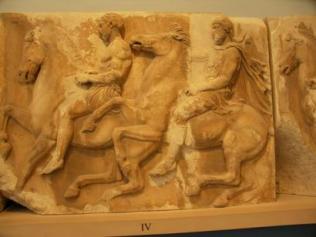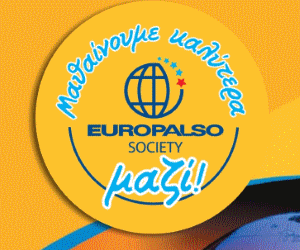PEOPLE are still influenced and informed by traditional, low-tech means through public monuments, gatherings and speeches, but are also targeted with messages and information on current events or matters of state through television, radio, internet and the print media. In ancient times, on the other hand, religious, political or social messages aimed at the public were commonly transmitted through sculpted, figural art. Public buildings were often designed as imposing, three-dimensional message boards.
Today, with central Athens again witnessing violent clashes between demonstrators and police, one has only to look to the Acropolis or the Acropolis Museum’s Parthenon Hall for age-old public reminders carved in stone that a civilised society’s resistance against barbarism and chaos is a timeless struggle, never to be forgotten .
Conflict is nothing new to the Acropolis, since by the mid-5th century BC the rocky promontory had already been the site of a Mycenaean fortress and the scene of at least one well-known assault: its sacking by the Persians in 480BC, during which the temple of Athena Polias and the unfinished Older Parthenon - an intended victory monument and thank-offering after the Battle of Marathon in 490BC - were destroyed by the vengeful Persians.
Following this grievous incident, according to author and Notre Dame professor Robin Rhodes, Athenian leaders rebuilt the north wall of the Acropolis, using the ruins of these two important public buildings to commemorate the shameful event, to warn of the ongoing Persian threat, to stir up local sentiment against this enemy and perhaps to symbolise the Athenians’ selfless sacrifice of their city to the general defence of the Greek mainland. Rhodes calls the Acropolis north wall “a unique monument in the history of Greece, [which] … is truly remarkable in its understanding of the potential power of ruins upon the emotions and imagination of people”.
On the Acropolis, Pericles, ancient Athens’ most renowned 5th century BC “mayor”, oversaw the construction (447-432 BC) of the highly visible Parthenon: not only a gleaming, white-marble temple dedicated to the city’s patron goddess Athena, but also a meaningful monument with three different types of elegantly carved sculpture. Freestanding statues stood in the temple’s east and west triangular pediments; figural metope panels - called the Doric frieze - appeared around the outside of the building above the Doric colonnade; and a series of scenes carved in relief - the Ionic frieze - wrapped continuously around the upper, exterior walls of the temple’s central naos or main chamber.
The Ionic frieze is the best preserved of the Parthenon’s three major types of sculpture and has received much attention from specialists. Since nearly all the Parthenon’s original sculpture has now been removed, however, and the extant figures on panels displayed in the Acropolis and British museums are so fragmentary or time-worn, visitors must rely on their imagination - what Cambridge art historian Mary Beard calls “the eye of faith” - to understand and appreciate the once-intricately carved sculptures’ original appearances and meaning.
At present, the only original sculptures remaining on the Parthenon are the metopes of the west end and one metope on the southern side of the southwest corner. As part of the current west-end restoration, this last southwestern panel will also soon be removed.
In general, the Parthenon’s inner Ionic frieze depicts a ceremonial parade of humans and animals that ends in the presence of an assembly of Olympian gods. This parade may have represented either 1) a generic procession; 2) the Greater Panathenaic procession held every four years, at the culmination of which a new robe (peplos) was presented as an offering to the ancient olive-wood cult statue of Athena Polias (housed in the adjacent Erechtheion); or perhaps, according to Rhodes, 3) a victory procession celebrating the Athenian-led defeat of the Persians (480-479BC), ending with Persian war booty being offered to the gods. Although the Panathenaic interpretation is the explanation most accepted by specialists, the latter suggestion is also appropriate and intriguing.
Athens’ struggles against its enemies, especially the Persians, and its military triumphs are major themes on the Acropolis, as indicated by the hill’s rebuilt, monumental north wall. The small but prominent Athena Nike temple also showcases various battle scenes in its own Ionic frieze. On the north side, University of Oregon classical archaeologist Jeffrey Hurwit reports, one sees the Athenians defeating the forces of Argos. On the south side, the Battle of Marathon is represented, while, on the west end, the Athenians are fighting to recover the bodies of the seven heroes who fought against Thebes.
On the east end, as on the east end of the Parthenon, a number of gods have assembled, either, according to Hurwit, “to honour Athena as guarantor of the victories depicted around the corners”, or - in a more recent theory by Greek specialist Olga Palagia - to witness the birth of Athena.
Sculptural message
The Parthenon also was a monument to Athenian victory over the Persians (see box). It was the first temple built on Acropolis after the Persian sack of 480BC and replaced the destroyed Older Parthenon meant to commemorate the triumphant battle at Marathon. Debate may continue on the meaning of the Parthenon’s Ionic frieze, but the messages of the metopes are clear.
On the north side are scenes from the Trojan War; on the south side mythical Lapith people fight with bestial centaurs; on the west end Greeks battle invading Amazons; while on the east end is depicted the Battle of the Gods against the Giants.
These sculptural series were read by ancient viewers to represent the struggle of Western Greeks against Eastern foes; civilised Greeks resisting natural brutish forces; Athenians defending their city against a foreign invasion and Greek gods preventing unruly monsters from overthrowing the cosmic order.
Through all of these conflicts (civilisation versus barbarism, reason versus passion, culture versus nature) ran the theme of Greeks, particularly Athenians, struggling against chaos and restoring the world to order.
Elsewhere on the Parthenon similar messages are transmitted. Rhodes claims that “the same struggle [seen on the metopes] between those irrational, hostile, bestial forces and the enlightened, reasoned world of civilisation and the Greeks is forcefully illustrated in the west pediment of the Parthenon, in the struggle between Poseidon and Athena for control of Athens”.
Divine contest
The west pediment depicts that mythical moment when the Athenians as judges chose Athena and her gift of the olive tree rather than Poseidon and his saltwater spring. Central among the west pediment’s freestanding sculptures, Poseidon stands firmly, Rhodes points out, as the God of earthquakes, the fearsome sea and the violent, uncontrollable forces of nature. Athena stands opposite him as the goddess of intellect: a symbol of wisdom, light and the positive forces of the cosmos.
The Parthenon’s east pediment depicts another mythical subject, the birth of Athena. This great event, staged as a sculptural narrative framed by the rising of the sun (Helios) on the pediment’s south end and the setting of the moon (Selene) on the north end, had enormous metaphorical meaning for the Athenians, as it also marked the dawning of a new day and age for Athens. In choosing Athena as their patroness, the Athenians caused their city to be reborn as a centre of intellectual power, wisdom, civilisation and light.
In Archaic or earlier times, the Athenians adopted Athena over Poseidon and chose to be farmers rather than sailors. In the Classical 5th century BC the Athenians reinvented themselves, became sailors again, with the encouragement of Themistocles, and through increased military might fought off the barbarians and restored civilisation from violent chaos. Now, with modernday chaos in the streets, perhaps the time has come again to “choose Athena”.
A monument to Athenian victory over barbarians
“The Parthenon was the first building constructed on the Acropolis following Athenian release from the Persian threat, the first building constructed out of the rubble left untouched for all those years as a reminder of that threat. As such, it must certainly be associated with the intention to present Athens as final victor over the Persians, as the new leader of Greece, the mistress of an empire formed to defend Greece against barbarian destruction.”
athensnews.gr
Τελευταία νέα
- EUROPALO Εγκύκλιος 17/04/2024: Διεθνής Ημέρα Αγγλικής Γλώσσας – Υποψήφιοι Ειδικής Μέριμνας ESB, EUROPALSO, ειδικές συνθήκες εξέτασης
- Διαδικτυακό σεμινάριο Speaking ESB, Σάββατο 20/4/2024, 11.00 π.μ.
- EUROPALSO Εγκύκλιος 10/04/2024: Διαδικτυακή παρουσίαση ΕΕΑ για πλατφόρμα CRM, 12/4 – Ημερομηνίες εξετάσεων Θερινής Περιόδου – Διαδικτυακό σεμινάριο Speaking ESB, 20/4 – Καλοκαιρινή εκδρομή στη Νάξο – Νέες αμοιβές, ωρομίσθια – Φορολογικά
- Αύξηση κατώτατου μισθού, από 1/4/2024: Τα νέα ωρομίσθια και οι αμοιβές για ΚΞΓ
- EUROPALSO - Τι είναι το IRIS - Τι ισχύει για τις επιχειρήσεις και ΚΞΓ
- Ψηφιακή πλατφόρμα τύπου CRM για Κέντρα Ξένων Γλωσσών - Δυνατότητες - Διαδικτυακή παρουσίαση για ιδιοκτήτες ΚΞΓ
- EUROPALSO Εγκύκλιος 02/04/2024: Ημερομηνίες εξετάσεων Θερινής Περιόδου – Διαδικτυακή παρουσίαση ΕΕΑ για πλατφόρμα CRM, 12/4 – Διαδικτυακό σεμινάριο Writing ESB, 6/4 – Εξετάσεις για ενήλικες – Νέες αμοιβές, ωρομίσθια – Εγγραφή σε σύστημα IRIS
- ReLearning with Express Publishing: Mια διαδραστική σειρά σεμιναρίων σε όλη την Ελλάδα!
- EUROPALSO - ΦΟΡΟΛΟΓΙΚΕΣ ΥΠΟΧΡΕΩΣΕΙΣ ΑΠΡΙΛΙΟΣ 2024
- Διαδικτυακό σεμινάριο Writing (ESB), Σάββατο 6/4/2024, 11.00 π.μ.


